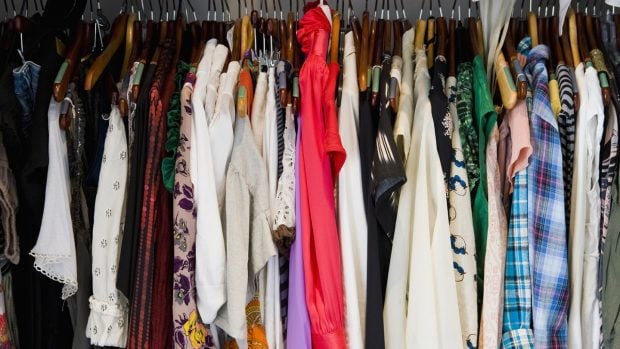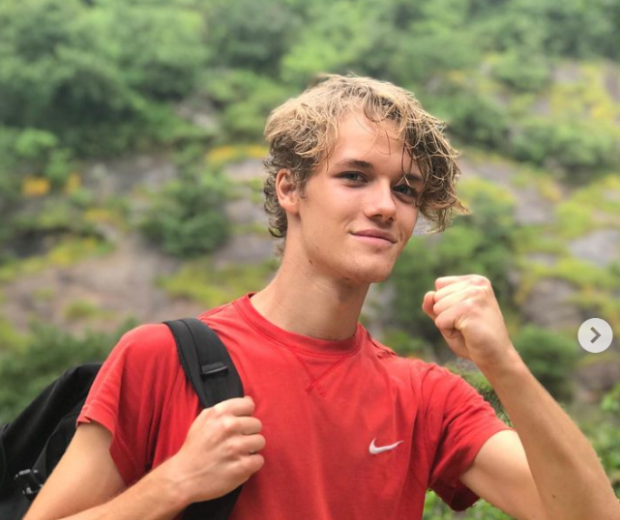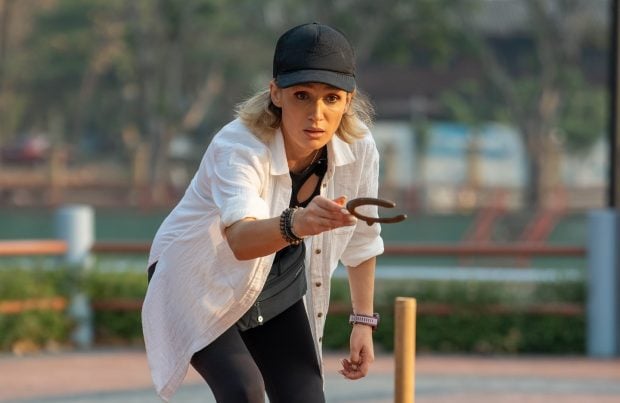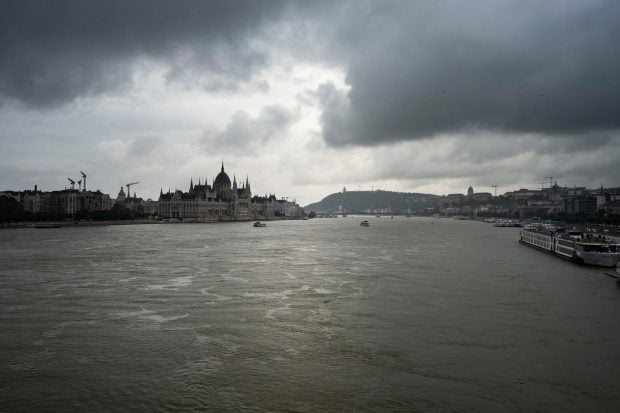One theme that connects many films at this year’s festival is that of internal journeys that force external ones. In writer Durga Chew-Bose’s directorial debut she adapts Françoise Sagan’s coming-of-age novel Bonjour Tristesse in order to explore how emotional maturation sometimes comes through acts of cruelty. Oscar-nominated cinematographer Rachel Morrison’s directorial debut “The Fire Inside,” explores the rocky journey to self-worth despite the inequities of the world through the story of two-time Olympian Claressa Shields. In Gia Coppola’s latest film “The Last Showgirl,” Pamela Anderson plays a dancer who no longer wants to fight with others for their acceptance, because she has already found it for herself.
An adaptation of Françoise Sagan’s acclaimed 1954 coming-of-age novel, “Bonjour Tristesse” is a twisted love triangle between a father, a daughter, and a woman from their past that was first brought to the big screen in 1958. That version, directed by Otto Preminger, was hampered by the production code, but had a fire to it thanks to the strength of its cast, which included Jean Seberg, David Niven, and Deborah Kerr. Both works leave one hell of a lineage to follow. It’s a bold project for a first-time feature film, and I applaud writer-director Durga Chew-Bose for the attempt, even if I find the execution a bit lacking.
Shot on the Mediterranean fishing port of Cassis, the film is as gorgeous as a picture postcard or a coffee table travel photography book. Chew-Bose evokes the source material’s mid-century setting through timeless art direction and costume design, although she slowly reveals her film’s modern setting through the occasional appearance of a cell phone. This timelessness is heightened by the film’s languid pace, itself seemingly inspired by the works of French auteur Éric Rohmer, master of summer malaise.
Herein lies the problem. While the Cécile of the book and earlier film is always a bit impish, Lily McInerny, who was so good a few years ago in the drama “Palm Trees and Power Lines,” plays the character as much more guarded, almost impenetrable as the film opens. This then means her big turn from mischievousness to cruelty comes almost too abruptly in the film’s rushed final sequences. Similarly, Claes Bang plays Cécile’s father Raymond almost as if he were on Xanax the whole film. His megawatt charm has been muted within an inch of its life.
Naïlia Harzoune is a wonder as Raymond’s current lover Elsa, her passion infusing the film with almost its sole sense of energy or life. Although the character is more reserved by design, Chloë Sevigny as Ann, the best friend of Cécile’s late mother and Raymond’s soon-to-be new lover, gives the best performance in the film. Behind her reserve is a scathing caustic wit, one that makes you think and makes you laugh. It’s a pity then that the leisurely pace hampers the escalation of emotions all three women feel, thus ending the film with a whimper rather than a bang. I’m sure the lowkey tone will work for some viewers, but for me, despite the beautifully rendered summer heat, the film ultimately left me cold.
It’s always interesting when a talented filmmaker in one of the film arts moves to another, so I was really excited for the directorial debut of Oscar-nominated cinematographer Rachel Morrison. It helps that for her debut “The Fire Inside” she is working with Oscar-winning producer and writer Barry Jenkins. Here the two have joined their talents together to bring the story of Claressa Shields (Ryan Destiny), a teenager with a traumatic background in Flint, Michigan who went on to become a two-time Olympic boxing champion, then fought for gender equity in terms of compensation for female athletes in the sport, to the big screen.
Although the film does hit a lot of the beats you’d expect for this kind of film as it outlines her journey towards Olympic gold, it does so with the kind of simple, lived-in details and empathy that Jenkins brought to his Best Picture-winner “Moonlight.” Claressa’s life is hard, but she will not be pitied, and the film never gazes with a distance. DP Rina Yang renders the broken down homes of Flint and the flashy world of the boxing matches with the same loving care, allowing the focus to stay solely on the power and passion of Claressa.
The best scenes in film are those between Claressa and her volunteer coach Jason Crutchfield, played by the great Brian Tyree Henry. With actors as strong as Henry, it’s wise to let them do the heavy lifting, and thankfully Morrison knows this. She understands the power of a look to sell a laugh or land an emotional beat, often holding on his face instead of cutting to reaction shots. While Henry’s comic timing with line delivery is always a treat, his expressive eyes may well be the strongest tool in his box. Destiny is equally great at imparting whole paragraph’s of emotion with just a single glance. Together they craft the kind of chemistry that happens between two people who know each other like a book, who can share a hard truth as easily as they can a laugh.
A lesser film might have stopped when Claressa won her Olympic gold, but that is only half the story. Claressa, like many female athletes, must face levels of misogyny around how women should present themselves out of the ring as well as in it. Or, as the PR rep for U.S.A. Boxing puts it, “It’s not fair but for women it’s not just about how skilled you are.” Claressa competed in the 2012 and 2016 Olympic Games, winning gold both years. Yet, just this summer eventual gold medalist Imane Khelif was subjected to similar, and in some cases even worse, forms of misogyny about her looks in and out of the ring. As the saying says, the more things change, the more they stay the same.
For the last decade I’ve been corresponding by mail with my 90-something Great Aunt Zay. She has shared stories of her life with me that she hasn’t with the rest of the family because I’m also “in the arts,” so, in her words, “I would understand.” She was a showgirl in the 1950s (before the acts were topless) and danced in revues in San Francisco, Chicago, Las Vegas, and Reno. Her family never understood her art. I thought of her often as I watched Pamela Anderson in Gia Coppola’s “The Last Showgirl.”
Anderson plays Shelley, the oldest dancer in a Las Vegas revue called Le Razzle Dazzle, the last of its kind on the strip. Shelley is an artist. She’s aware of the show’s lineage, its direct connection to the Parisian Lido culture. But times have changed. The younger dancers in the show (Brenda Song, Kiernan Shipka) see it as just another gig. Even her own estranged daughter (Billie Lourd) sees it as just a “nudie show” with dances that aren’t that hard. But for Shelley, it’s the dream writ large. It’s “breasts and rhinestones and joy!” she exclaims.
Shelley has given life to this art, feels alive in the spotlight, reveling in the power of being seen. She’s 57 years old, but she knows she’s still beautiful, even if the world tells her she’s not. She’s done her best living for her art, raising a kid in a world that values the work of stage manager Eddie (Dave Bautista), who has a pension and a health insurance, which she, despite her decades with the show, does not, more than her art. She’s a legend. She’s the face on the posters. She’s living paycheck to paycheck. Coppola sees the dignity in living for your art. She never pities women like Shelley, or her best friend Annette (Jamie Lee Curtis), a gambling addicted former dancer turned cocktail waitress. Coppola sees the beauty, in the classical sense, of their art, as it preserves despite the decay all around them.
As Shelley, Anderson is a revelation, bringing the same balance of buoyancy and pathos that Judy Holliday brought to each of her roles. Equally as comfortable in the sequins and glitter and gauze of the job as she is going makeup-less on her days off. As with Anderson, Shelley has not been taken seriously as an artist, and sometimes even as a person. When she says, “I’m tired of defending myself” and that she has no regrets for her life’s choices, it’s hard not to see Anderson’s own emotional truth shine through Shelley’s words. “The Last Showgirl,” is a film about beauty and truth and love. It broke my heart as much as it uplifted it. Women like Shelley, and Pam, and my Great Aunt Zay should never have had to defend their existence to anyone in







:format(jpeg):quality(80)/wp-content/uploads/2024/09/omar-arnaout-primul-castigator-nextstar-a-devenit-tatic-sursa-foto-montaj-fanatik.jpg)

:format(jpeg):quality(80)/wp-content/uploads/2024/09/betano-1609.jpg)
:format(jpeg):quality(80)/wp-content/uploads/2024/09/padure-delta-dunarii.jpg)
:format(jpeg):quality(80)/wp-content/uploads/2024/09/calin-donca-lamborghini-disparut.jpg)

:format(jpeg):quality(80)/wp-content/uploads/2024/09/apele-romane.jpg)
:format(jpeg):quality(80)/wp-content/uploads/2024/09/joaca-impreuna-la-joaca-la-juventus-torino-dar-sunt-remunerati-diferit.jpg)

:format(jpeg):quality(80)/wp-content/uploads/2024/09/mesajul-astrelor-17-septembrie.jpg)
:format(jpeg):quality(80)/wp-content/uploads/2024/09/rigas.jpg)









:format(jpeg):quality(80)/wp-content/uploads/2024/09/becks-ok.jpg)


